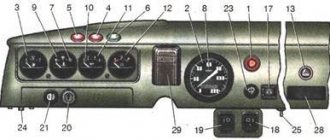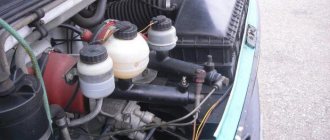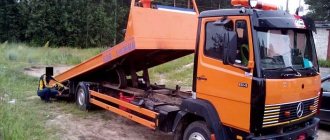Tuning Mercedes T1: initial stage
Carbon is a high-tech material that allows you to transform the appearance of any vehicle. It will not take much time to produce the required part. Plus, you don't need to have any technical skills to do this.
It's best to start working with simple shapes. In this case, safety requirements must be observed. After all, the resins emitted by the material can cause quite a severe headache. Rubber gloves and face and throat protection must be used. Tuning a Mercedes T1 must be done very carefully so as not to damage other parts and get the desired effect.
Technical equipment of the Mercedes truck 207D
Production of the models ended in 1995, but their demand among modern buyers is still high. After all, the Mercedes 207D van has quite good technical characteristics, despite its outdated equipment. The power of the installed engine is 65 hp. or 72 hp The indicators are sufficient for private transportation of passengers or transportation of small-sized cargo.
The models are equipped with 5-speed gearboxes (automatic or manual). The car frame is made of a steel profile attached to the floor of the body. This design can withstand high loads (from 820 to 2580 kg). The front double-wishbone suspension holds the road well even when the car is heavily loaded, and the rear leaf spring suspension ensures a smooth ride.
Freight transport differs from the German automobile industry in its convenient arrangement. And the Mercedes Benz 207D model was no exception. The vans were equipped with hinged or sliding doors and double doors at the rear.
This design of the model allows it to be used for transporting large loads. In some modifications, a rear step is installed upon request, making loading more comfortable.
Tuning Mercedes T1: creating a dashboard
A flat dashboard is the first detail we recommend creating. It is universal and suitable for various car models. If you decide to tune a Mercedes T1, then try to create such a panel for this car. Solving such a problem does not require serious expenses: neither in terms of materials nor in terms of financial resources spent.
We recommend using aluminum as the main workpiece. From it you can create parts of the required shape. In addition, you can additionally use two waxed glasses. They will help in the future to cut holes in the carbon fiber as the corresponding part is ready. Preliminarily mark the centers of future holes with a core. After this, you will need a drill. To get the job done, it is best to purchase a ring model. It can be purchased at any construction and even automobile store.
Van on the Mercedes-Benz T1 410D chassis, produced in 1989, operating features
An old truck that's better than a new one
S. Iones, photo by the author
There are a lot of Mercedes-Benz T1 series trucks, minibuses and vans produced in 1979–1995 in our country. We will devote a separate story to the operating features of various modifications of this family, and today we will get acquainted with a version of such a car that is rarely seen in Russia.
On Russian roads there are many old cars from famous world manufacturers. We often hear the opinion that “ancient” foreign cars, including trucks, are rubbish, the import of which requires increased duties and administrative restrictions. But for the average owner, perhaps an old foreign car is a good purchase, an excellent alternative to a new domestic truck.
We met this unusual van on the Mercedes-Benz T1 chassis in the town of Fryazino near Moscow. At first glance, it can be mistaken for a homemade product. But the current owner did not build this car. He chose not a GAZelle or a Bull as a vehicle, but a 1989 Mercedes.
In terms of cabin size and axle track, the Mercedes of this series are close to our GAZelle. But there are many modifications that differ in body type, load capacity, gross weight and wheelbase length. This machine has an index of 410, which means the total weight is more than 4 tons. This is one of the largest modifications. This vehicle has the longest base length in the family - 3.7 m, and the total weight is 4.6 tons. According to the passport, the body can accommodate 22 m3 of cargo. But, according to the driver, the van holds 24 m3. The carrying capacity is greater than that of the basic model “Bychka” - 3.5 tons.
Initially, the body was intended for transporting frozen products: there was a refrigeration unit on the roof, the walls were thermally insulated, and rows of thin tubes through which the refrigerant was supplied were visible on the inside of the sides. But one of the previous owners did not need an old “refrigerator”, but a universal machine capable of transporting large quantities of industrial goods, furniture, and other large cargo. Therefore, the refrigeration unit was removed and the walls were lined with carpet from the inside.
There are no nameplates on the car indicating which European company built the body. The external panels and the “stuffing” of the sides are made much more carefully than those of domestic isothermal vans and refrigerators. Touching the side panel with your hand, you might think that the steel supporting frame is sheathed on the outside with plastic panels. In fact, the vertical strips of skin are made of thin aluminum sheet. The bottom of the van is made of a single sheet of plywood. The rear door hinges are thought out not only from a design point of view. They are convenient to lubricate thanks to the built-in grease nipples.
It would seem that a tall van should sway unpleasantly when cornering. This Mercedes surprises with its excellent stability. Even if you enter a turn at a speed of 100 km/h, an empty or not very loaded car does not frighten the driver with rolls and swaying. The body is very light and the center of gravity is low.
Previously, the van was equipped with a tail lift. The current owner has decided to abandon this device. It's not just that the old side lift mechanism required repairs. The car carried about 800 kg of ballast, not within the wheelbase, but on the tail. This worsened the weight distribution and overloaded the rear wheels of the empty van. By removing the side, the owner noticeably increased the load capacity and, apparently, improved handling. And since the loading height of this vehicle is less than that of the GAZelle, the elimination of the lift did not complicate the loading work.
The most noticeable detail that distinguishes this Mercedes is the impressively sized sleeping compartment on the roof of the cabin. One of the previous owners was obviously involved in intercity transportation. The “sleeping bag” body, made of fiberglass, is clearly not homemade. Well-designed external surfaces, high-quality upholstery of the internal walls, and a neat ventilation hatch indicate industrial production. Such “sleeping rooms” were built by small companies in the Baltic countries in the 1990s. The only window is located on the left side, and a hatch with folding plywood doors, like the doors of a city bus, leads from the cabin to the sleeping compartment. The “sleeping bag” was heated by an autonomous heater installed in the cabin; the hot air supply hose to the “second” floor was located in the right rear corner of the cabin. Two small fairings made of thin aluminum sheet, installed on the sides of the cabin, are designed to improve aerodynamics - a successful addition to the “sleeping bag”.
In the metropolitan region, among the Mercedes-Benz T1 with an index starting with four, there are usually wagon-type vans and buses with single rear tires. There are significantly fewer vehicles with a separate cabin and double wheels - potential buyers of such trucks usually choose Mercedes of the heavier family.
For such a large car, the wheel size is unexpectedly small: “passenger” 14 inches instead of the expected 16. It was not difficult to find tires suitable for the load capacity index, and they were domestic, from the Yaroslavl plant. Therefore, the ground clearance is modest, especially under the rear axle gearbox. But small wheels lower the center of gravity and loading height.
The differential lock helps prevent you from getting stuck in a puddle of mud or a snowdrift; the differential lock helps you move off on icy surfaces. This device was equipped with some modifications of the T1 family. The presence of a locking mechanism is revealed by two parts. On the rear axle housing to the left of the gearbox there is a hydraulic cylinder, similar in appearance to a brake cylinder. And on the dashboard there is a warning lamp with characteristic symbols.
I have heard from drivers and mechanics that some old MercedesBenz truck models have “eternal” units with a huge resource. The fate of this car confirms this opinion. Over the course of 17 years, the car traveled at least a million kilometers. The current owner alone has managed to accumulate more than 250 thousand. Is it any wonder that the OM-602 5-cylinder diesel engine still does not require serious repairs? The owner did not have to remove the engine from the car and disassemble it in order to replace liners, piston rings, crankshaft seals, and there was no need to repair the head. Since the engine is “trouble-free,” the experienced driver is not embarrassed by the fact that it is difficult to remove the hood cover from the cab on cars of this family; the seat must be removed. And changing the oil, air and fuel filters is not particularly difficult: a small hood lid provides convenient access to the oil neck and filters.
There is nothing strange in the fact that the gearbox and rear axle work properly, never requiring repair. But the fact that with such a mileage the current owner did not change the clutch or repair the driveshaft crosspieces will greatly surprise a person who has dealt only with domestic cars all his life. But one component of the chassis of the German truck still required repair. The current owner had to change the worn-out front axle king pins. When the muffler fell into disrepair, instead of the “branded” one, we managed to make a homemade one.
The old MercedesBenz cannot be compared with the GAZelle and Bychk not only in terms of reliability and durability - the car pleases the driver with stability, maneuverability, and smoothness. The suspension is traditional for a truck - axle beams on longitudinal springs. The front springs are small-leaf, consisting of only two leaves, and the rear springs are ordinary, they have seven leaves. In combination with a long wheelbase, they provide a smooth, car-like ride even when the van is empty. One of the few shortcomings is the rather weak headlights.
Only an incompetent person can declare that “all” old cars are “junk”. Simple in design, a well-assembled truck is truly capable of serving “forever.” Even if the car has a huge mileage, even if there are many cosmetic defects, even if significant elements of additional equipment have been lost. The main thing is that an old Mercedes is more convenient for the driver than a domestic truck, and it is profitable to operate it.
The editors thank Sergei Danilov and Ivan Romanov for providing the car.
Tuning Mercedes T1: main nuances and finishing work
When the aluminum base is ready, it is necessary to carefully treat the surface. To do this, use “100” sandpaper (abrasive particles). Such measures are necessary to ensure that it does not have roughness and is smooth. When tuning a Mercedes T1, you need to pay special attention not only to the external part of the parts, but also to the internal part. This will make the part even more functional and reliable.
Without the above steps, the resin will not stick to the base. In addition, the aluminum itself must be sanded and coated with resin. Soft spatulas are perfect for this. Therefore, Mercedes T1 tuning can be carried out in the future, making other modifications and improving the car’s components.










